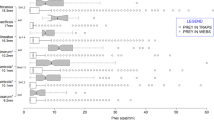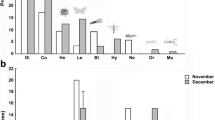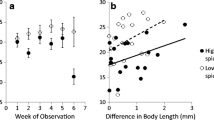Summary
Because of the large amount of webbing they provide, social spider colonies often host other satellite spider species referred to as kleptoparasites or food stealers. Such kleptoparasites may take advantage of increased prey capture rates associated with large spider aggregations. This study investigated the relationship between a cooperatively social spider species, Anelosimus eximius (Araneae: Theridiidae), which lives in the undergrowth of tropical rainforests in Peru, and its kleptoparasite, Argyrodes ululans (Araneae: Theridiidae), which specializes in foraging in An. eximius webs. Although large aggregates of spiders may be more attractive to kleptoparasites, the benefits of group defense may offset this cost. Natural colonies were observed, and enclosed field colonies containing fixed numbers of host spiders were manipulated in order to determine whether kleptoparasite success is affected by the number of social spiders that are available for defense. Prey was less likely to be stolen by Ar. ululans when a greater number of host An. eximius spiders were involved in prey capture. When hosts detected a kleptoparasite earlier and chased it more often, prey was more likely to be successfully defended. Ar. ululans was more successful in stealing small prey items in all colonies and gave up more readily on very large prey (> 11 mm). I conclude that communal living and group defense in An. eximius confer protection from the kleptoparasite Ar. ululans.
Similar content being viewed by others
References
Barnard CJ (1984) The evolution of food-scrounging strategies within and between species. In: Barnard CJ (ed) Producers and scroungers. Chrom Helm, Beckenham, pp 95–126
Barnard CJ, Thompson DBA (1985) Gulls and plovers: the ecology and behavior of mixed-species feeding groups. Columbia University Press, New York
Brockmann HJ, Barnard CJ (1979) Kleptoparasitism in birds. Anim Behav 27:487–514
Buskirk RE (1981) Sociality in the Arachnida. In: Hermann HR (ed) Social insects, vol II. Academic Press, New York, pp 282–393
Cangialosi KR (1990) The behavioral and ecological interactions of the kleptoparasitic spider, Argyrodes ululans, and its social spider host, Anelosimus eximius. PhD dissertation, Miami University, Oxford, OH
Christenson TE (1984) Behaviour of colonial and solitary spiders of the Theridiid species Anelosimus eximius. Anim Behav 32:725–734
Curio E (1976) The ethology of predation. Springer, Berlin Heidelberg New York
Dawkins R, Krebs JR (1979) Arms races between and within species. Proc R Soc London Ser B 205:489–511 orb-weaving spider. Anim Behav 1052–1054
Erwin TL (1985) Tambopata reserved zone, Madre de Dios, Peru: history and description of the reserve. Rev Peru Entomol 27:1–8
Exline H, Levi HW (1962) American spiders of the genus Argyrodes (Araneae, Theridiidae). Bull Mus Comp Zool, Harv Univ 127:75–204
Gertsch WJ (1979) American spiders. Van Nostrand Reinhold, New York
Griswold CE, Meikle-Griswold T (1987) Archaeodictyna ulova, new species (Araneae: Dictynidae), a remarkable kleptoparasite of group-living Eresid spiders (Stegodyphus spp., Araneae: Eresidae). Am Mus Novit 2897:1–11
Grubb TC (1971) Bald eagles stealing fish from common mergansers. Auk 88:928–929
Kallander H (1977) Piracy by black-headed gulls on lapwings. Bird Study 16:45–52
Kruuk H (1972) The spotted hyena: a study of predation and social behavior. University of Chicago Press, Chicago
Kushlan JA (1978) Nonrigorous foraging by robbing egrets. Ecology 59:649–653
Pulliam HR (1973) On the advantages of flocking. J Theor Biol 38:419–422
Pulliam HR, Caraco T (1984) Living in groups: is there an optimal group size? In: Krebs JR, Davies NB (eds) Behavioral ecology: an evolutionary approach, 2nd edn. Sinauer, Sunderland
Rypstra AL (1981) The effect of kleptoparasitism on prey consumption and web relocation in a Peruvian population of the spider Nephila clavipes. Oikos 37:179–182
Rypstra AL (1989) Foraging success of solitary and aggregated spiders: insights into flock formation. Anim Behav 37:274–281
Schaller GB (1972) The Serengeti lion: a study of predator-prey relations. University of Chicago Press, Chicago
Smith Trail DS (1980) Predation by Argyrodes (Theridiidae) on solitary and communal spiders. Psyche 87:349–355
Uetz GW (1986) Web building and prey capture in communal orb weavers. In: Shear WA (ed) Spiders: webs, behavior and evolution. Stanford University Press, Stanford
Vollrath F (1979) Behaviour of the kleptoparasitic spider Argyrodes elevatus (Araneae, Theridiidae). Anim Behav 27:515–521
Vollrath F (1984) Kleptobiotic interactions in invertebrates. In: Barnard CJ (ed) Producers and scroungers. Chrom Helm, Beckenham
Vollrath F (1987) Kleptobiotis in spiders. In: Nentwig W (ed) Ecophysiology of spiders. Springer, Berlin Heidelberg New York
Vollrath F, Rohde-Arndt D (1983) Prey capture and feeding in the communal spider Anelosimus eximius. Z Tierpsychol 61:313–324
Wilson EO (1975) Sociobiology: the modern synthesis. Harvard University Press, Cambridge
Wittenberger JF (1981) Animal social behavior. Duxbury Press, Boston
Author information
Authors and Affiliations
Rights and permissions
About this article
Cite this article
Cangialosi, K.R. Social spider defense against kleptoparasitism. Behav Ecol Sociobiol 27, 49–54 (1990). https://doi.org/10.1007/BF00183313
Received:
Accepted:
Issue Date:
DOI: https://doi.org/10.1007/BF00183313




